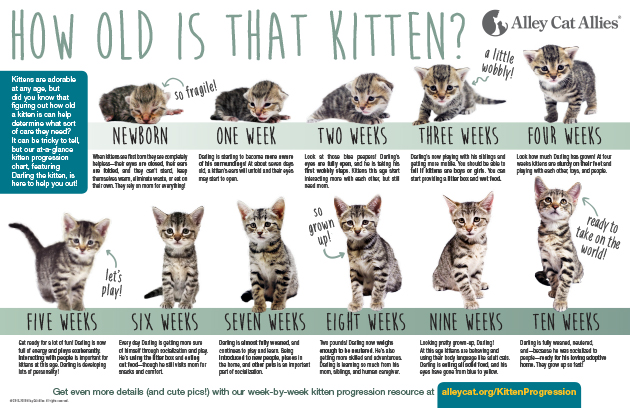To tell how old a kitten is, check their teeth and eyes for developmental clues. The kitten’s size and behavior can also indicate their age.
Welcoming a new kitten into your home is an exciting time. As a responsible pet owner, it’s important to determine the age of your new feline friend to provide the appropriate care. Whether you’ve found a stray kitten or adopted one from a shelter, knowing how to estimate their age can help you meet their specific needs.
By observing certain physical and behavioral characteristics, you can make an educated guess about how old your kitten is. Let’s explore some key indicators that can help you determine the age of a kitten.

Credit: www.reddit.com
Introduction To Kitten Age Identification
Discovering a kitten’s age involves examining their teeth, eyes, and behavior cues to estimate their development stage accurately. By observing physical characteristics and behaviors, you can determine the approximate age of a kitten with reasonable accuracy.
The Importance Of Knowing A Kitten’s Age
Knowing a kitten’s age is crucial for their proper care and development. Understanding their age helps determine the appropriate nutrition, vaccinations, and socialization they require. It allows you to anticipate their growth milestones and behavior changes, enabling you to provide the best possible care and create a nurturing environment for them.
Challenges In Determining Kitten Age
Identifying the age of a kitten can be challenging, especially if you don’t have access to their birth records or have limited knowledge of feline development. Unlike puppies, kittens do not have easily distinguishable physical characteristics that indicate their age. However, there are several indicators you can look for to estimate their age with reasonable accuracy.
One of the primary challenges in determining a kitten’s age is that their appearance can be deceptive. Kittens grow rapidly during their first few weeks, and their physical features change accordingly. Therefore, relying solely on size or weight can be misleading. Instead, it’s important to observe various developmental milestones and physical attributes to make a more accurate assessment.
Another challenge arises when dealing with kittens of unknown parentage or mixed breed. Different breeds can have variations in growth patterns and physical characteristics, making it harder to pinpoint the exact age.
Fortunately, there are several methods and guidelines that can help you estimate a kitten’s age, taking into account their behavior, teeth, eyes, ears, and overall physical development. By combining these indicators, you can make an educated guess about their age and provide appropriate care.
Physical Features And Developmental Milestones
Determining a kitten’s age involves examining physical traits and developmental milestones. Look at the teeth, eyes, and overall size to estimate their age accurately. Pay attention to behaviors like walking and playing to gauge their stage of growth.
When adopting a kitten, it’s important to know their age to ensure they receive the right care and nutrition. While it can be difficult to determine a kitten’s age, there are some physical features and developmental milestones you can look for.
Weight And Size As Age Indicators
A kitten’s weight and size can provide clues to their age. How to Tell How Old a Kitten Is? Newborn kittens typically weigh between 3-4 ounces, and their weight should double within the first week. By four weeks old, kittens should weigh around one pound, and their weight should continue to increase steadily until they reach their full adult size at around one year old.
Teeth Development Stages
The development of a kitten’s teeth can also indicate their age. Kittens are born without teeth, and their baby teeth, also known as deciduous teeth, start to come in at around two weeks old. By six weeks old, a kitten should have all their baby teeth, and they will start to lose them at around three months old. Adult teeth will start to come in at around four months old, and the process should be complete by six or seven months old.
Physical Developmental Milestones
Along with weight, size, and teeth development, there are other physical developmental milestones that can help determine a kitten’s age. Here are some examples:
- Eyes: Kittens are born with closed eyes, which will start to open at around 7-10 days old. Their eyes will be fully open by two weeks old.
- Walking: At around three weeks old, kittens will start to wobble around on unsteady legs, and they will start walking confidently at around four weeks old.
- Coordination: By six weeks old, kittens should have good coordination and be able to run, pounce, and play without falling over.
- Reproductive development: Kittens can reach sexual maturity as early as four months old, so it’s important to get them spayed or neutered at around that age.
By looking at a kitten’s weight, teeth development, and physical milestones, you can get a good idea of their age. However, it’s always best to consult with a veterinarian to get an accurate assessment and to ensure your kitten is receiving the proper care and nutrition they need at every stage of their development.
Behavioral Clues To Estimate Kitten Age
When you come across a cute little kitten, one of the first questions that may pop into your mind is, “How old is this adorable furball?” While it may not be possible to determine their exact age without veterinary assistance, there are several behavioral clues that can give you a rough estimate. By observing their mobility and playfulness levels, as well as their socialization and interaction signs, you can get a better idea of where they fall on the age spectrum. Let’s dive into these behavioral cues to help you determine the age of a kitten.
Mobility And Playfulness Levels
One way to estimate a kitten’s age is by observing their mobility and playfulness levels. Younger kittens, typically between 1 to 3 weeks old, are generally unable to walk steadily or play actively. They rely heavily on their mother for warmth, food, and mobility. As they grow older, around 3 to 4 weeks,
kittens start to explore their surroundings and attempt to walk on their own. By 5 to 6 weeks, they become more coordinated and engage in playful behavior, chasing after toys or their littermates. Older kittens, around 7 to 8 weeks, exhibit increased agility and enjoy pouncing and climbing. By paying attention to their mobility and playfulness, you can make an educated guess about their age.
Socialization And Interaction Signs
Another clue to estimating a kitten’s age lies in their socialization and interaction signs. Younger kittens, around 2 to 3 weeks old, are typically more dependent on their mother and littermates. They seek comfort and warmth by staying close to their family. As they grow older, around 4 to 5 weeks, kittens become more curious and start to explore their surroundings.
They may show interest in interacting with humans, although their social skills are still developing. By 6 to 7 weeks, kittens become more confident and actively seek out human attention. They may purr, rub against your legs, or initiate play. Older kittens, around 8 to 10 weeks, are usually well-socialized and enjoy human company. They may even respond to their names or follow basic commands. By observing their socialization and interaction signs, you can gain insights into their age.
While these behavioral clues can give you a general idea of a kitten’s age, it’s important to remember that individual variations exist, and consulting a veterinarian is the best way to get an accurate assessment. By paying attention to their mobility, playfulness, socialization, and interaction signs, you can make an informed guess and provide the best care for your adorable new feline friend.
Eye And Ear Development
The development of a kitten’s eyes and ears can provide clues to its age. Newborn kittens are born with closed eyes and ear canals, which typically open within the first two weeks. As they mature, the eyes and ears become fully functional, helping to determine their age.
Eye and ear development in kittens can provide valuable clues about their age. Understanding the changes in eye color and ear movement and position can help in determining the age of a kitten.
Changes In Eye Color
Kittens are born with closed eyelids, and their eyes typically open when they are around 7 to 10 days old. At this stage, their eyes are usually blue. As they grow, the eye color may change, and by the time they are 7 to 8 weeks old, their eyes may have reached their permanent color.
Ear Movement And Position
The ear movement and position of kittens also change as they grow. Newborn kittens’ ears are folded and their ear canals are closed. At around 10 days of age, their ears start to unfold, and the ear canals begin to open. By the time they are around 3 weeks old, their ears are fully erect and they can move them to locate sounds. This development of ear movement and position can be a helpful indicator of a kitten’s age. Understanding the changes in eye color and ear movement and position can assist in estimating a kitten’s age with greater accuracy.
Coat And Claws Examination
Examining the coat and claws of a kitten can provide valuable insights into their age and development. By observing the texture and patterns of their fur, as well as the growth and sharpness of their claws, you can make an informed estimation of their age. Let’s explore these indicators in more detail:
Fur Texture And Patterns
The texture and patterns of a kitten’s fur can change as they grow older. In their early weeks, kittens often have a soft and fuzzy coat. As they mature, their fur becomes denser and more sleek. By gently running your fingers through their fur, you can feel the difference in texture.
Additionally, the patterns on a kitten’s fur can also provide clues about their age. Some kittens are born with solid-colored coats, while others may have distinct markings or stripes. These patterns can become more pronounced as the kitten grows, helping you estimate their age.
Claw Growth And Sharpness
Another aspect to consider when determining a kitten’s age is the growth and sharpness of their claws. Kittens are born with tiny, undeveloped claws that gradually grow and become sharper over time. By gently inspecting their claws, you can assess their length and sharpness.
A younger kitten will typically have shorter and less sharp claws, while older kittens will have longer and sharper claws. However, it’s important to handle their paws with care to avoid any discomfort or injury.
Remember that these indicators provide general guidelines for estimating a kitten’s age and may not be entirely accurate. If you are uncertain about a kitten’s age, it is always best to consult a veterinarian for a professional assessment.

Credit: www.alleycat.org
Feeding And Nutrition Needs By Age
Weaning Stages And Solid Food Transition
It’s crucial to understand the weaning stages and solid food transition when determining how old a kitten is. Kittens typically start the weaning process at around four weeks old, gradually transitioning from their mother’s milk to solid food. During this period, it’s essential to introduce them to wet food mixed with kitten formula to ease the transition. As they grow, the amount of wet food can be increased, and around eight weeks old, kittens can primarily consume solid food.
Dietary Requirements For Different Ages
Understanding the dietary requirements for kittens at various ages is essential for their health and development.
- Birth to 4 weeks: Kittens should only be fed their mother’s milk or a suitable milk replacement formula.
- 4 to 8 weeks: Introduce wet food mixed with kitten formula to facilitate the weaning process.
- 8 weeks and older: Kittens can transition to primarily consuming solid food, which should be formulated specifically for kittens to meet their nutritional needs.
Providing the right nutrition at each stage is vital for ensuring healthy growth and development for kittens.
Health Checkups And Vaccination Timeline
When it comes to the health of your kitten, regular checkups and vaccinations are crucial. Understanding the Health Checkups and Vaccination Timeline is essential for ensuring your kitten grows up healthy and strong.
Common Health Indicators
Watch out for these key indicators to assess your kitten’s health:
- Weight gain and appetite
- Grooming habits and coat condition
- Energy levels and behavior
Vaccine Schedule Alignment
Follow this timeline to keep your kitten up to date with vaccinations:
| Vaccine | Age |
|---|---|
| Rhinotracheitis, Calicivirus, Panleukopenia (FVRCP) | 8-9 weeks |
| Feline Leukemia (FeLV) | 9-12 weeks |
| Rabies | 12-16 weeks |
Consulting With Professionals
Consulting with professionals can help determine the age of a kitten. By observing their teeth, size, and behavior, experts can provide valuable insights. This information is crucial for providing appropriate care and ensuring the kitten’s well-being.
When To Seek A Veterinarian’s Help
Sometimes, it’s best to consult a vet for accurate age determination.
Rescue Organizations And Age Assessment
Rescue groups are adept at estimating a kitten’s age based on their experience. Consulting with Professionals If unsure of a kitten’s age, consider seeking help from experts. Veterinarians can provide precise age estimates for kittens. Rescue organizations are skilled in assessing a kitten’s age accurately. In some cases, a vet’s opinion is necessary for accurate age determination. Rescue groups can also assist in determining a kitten’s age reliably.
When To Seek A Veterinarian’s Help
Rescue Organizations And Age Assessment
Frequently Asked Questions
How Can I Tell The Age Of A Kitten?
To determine a kitten’s age, check their teeth, eyes, and behavior. Newborns have closed eyes and folded ears, while 2-week-olds’ eyes start to open. By 4 weeks, their ears are fully upright. At 8 weeks, they have all their teeth.
What Are The Signs Of A Young Kitten?
Young kittens display specific behaviors. They are curious, playful, and have boundless energy. They may also be more vocal and prone to teething. Understanding these signs can help gauge a kitten’s age and cater to their needs accordingly.
What Milestones Indicate A Kitten’s Age?
Kittens reach developmental milestones at different ages. Their eyes open at 7 to 10 days, they start walking at 3 weeks, and by 8 weeks, they are fully weaned. By observing these milestones, you can estimate their age accurately.
Conclusion
Determining the age of a kitten can be challenging, but there are a few key factors to look for. By examining their eyes, teeth, and overall size, you can make an educated guess about their age. Remember, it’s important to provide kittens with proper care and nutrition based on their age.
By following these guidelines, you can ensure your kitten grows up happy and healthy.


